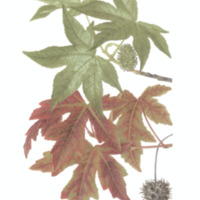Storax/styrax
Dublin Core
Title
Subject
Description
Liquidambar orientalis comes from Turkey. It is also known as “Turkish sweetgum”. It is widely distributed across southwestern Anatolia nowadays.
Benzoin styrax is found across Southeast Asia and in particular the island of Sumatra.
As early as the 6th century, storax was transported from Egypt to Rome for use in churches. It was one among a large quantity of aromatics that were imported to Rome. According to a recently-edited manuscript of the tenth-century Egyptian Muḥammad b. Aḥmad al-Tamīmī’, storax was also used in dyeing recipes along with saffron, sandalwood, and musk during that time. In the early modern and modern period, storax is recorded in Mexican pharmacies during Spanish colonial rule. It belonged to the European medicinal corpus that was brought to the New World.
Source
Fol. 7v - "For relieving the pain of G."
Take half a lb of finely pulverized golden & yellow marcasite, half an ounce of storax, 4 lb of urine, incorporate everything well together, little by little, in a mortar, then boil all together quite thoroughly. But the pot needs to be well covered in order that the fumes do not exhale. Next distill the urine, imbibed & separated by inclination, in an alembic, well-luted & covered with a copper helmet & soak a linen cloth with the said water & apply it lukewarm on the pain.
Contributor
Nicole Basile, “Gout or Gonorrhea? The Riddle of G.” in Secrets of Craft and Nature in Renaissance France. A Digital Critical Edition and English Translation of BnF Ms. Fr. 640, ed. Making and Knowing Project, Pamela H. Smith, Naomi Rosenkranz, Tianna Helena Uchacz, Tillmann Taape, Clément Godbarge, Sophie Pitman, Jenny Boulboullé, Joel Klein, Donna Bilak, Marc Smith, and Terry Catapano (New York: Making and Knowing Project, 2020), https://edition640.makingandknowing.org/#/essays/ann_054_sp_17. DOI: https://www.doi.org/10.7916/pc0c-te91.
Paula De Vos, “The ‘Prince of Medicine’: Yūḥannā Ibn Māsawayh and the Foundations of the Western Pharmaceutical Tradition,” Isis 104, no. 4 (2013), https://doi.org/10.1086/674940.
Anya H. King, “Gilding Textiles and Printing Blocks in Tenth-Century Egypt,” Journal of the American Oriental Society 140, no. 2 (2020), https://doi.org/10.7817/jameroriesoci.140.2.0455.
Louis Duchesne, ed., Le Liber Pontificalis: Texte, introduction et commentaire (Paris: E. Thorin, 1886), I, pp. 174, 177–8, 183. Also Atchley, Use of Incense, p. 141.
"Storax," in The American Heritage Dictionary of Medicine, edited by The Editors of the American Heritage Dictionaries, 2nd ed, Houghton Mifflin (2015).
Image: Faik, Yaltırık and Asuman Efe. “386. LIQUIDAMBAR ORIENTALIS: Hamamelidaceae.” Curtis’s Botanical Magazine 17, no. 2 (2000), http://www.jstor.org/stable/45065424.
